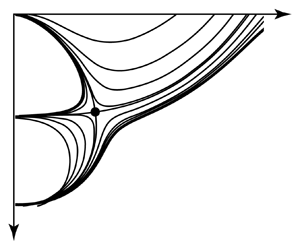Published online by Cambridge University Press: 28 April 2023

In this paper, the possibility of absolute instability in a plane unidirectional jet is analysed. We consider a parametrized family of velocity profiles with variable inflection point location and shear layer thickness. Using the inviscid saddle-point analysis, we show that absolute instability can occur in the case of a sufficiently low velocity at the inflection point or a sufficiently thin shear layer. Then we proceed to the viscous analysis and find the critical Reynolds numbers separating the zones of convective and absolute instability. We obtained a minimum value  $Re = 315$. As an independent verification of the theoretical results, we conduct a direct numerical simulation of the evolution of a localized pulse perturbation in the framework of the linearized Navier–Stokes equations. The calculated absolute/convective instability boundary is in a good agreement with theoretical results of the saddle-point analysis.
$Re = 315$. As an independent verification of the theoretical results, we conduct a direct numerical simulation of the evolution of a localized pulse perturbation in the framework of the linearized Navier–Stokes equations. The calculated absolute/convective instability boundary is in a good agreement with theoretical results of the saddle-point analysis.